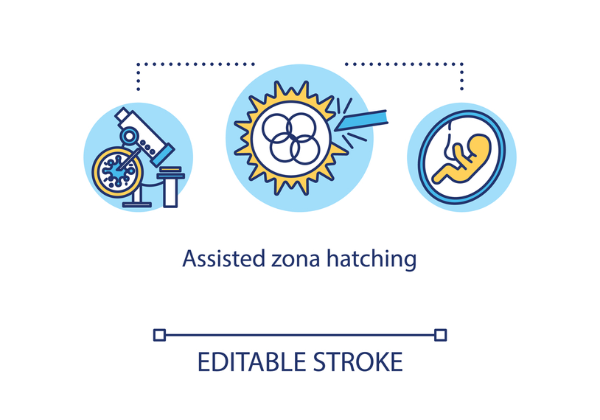Laser Hatching in IVF
The advent of the laser has allowed the development of precision techniques to manipulate embryos for enhanced fertility. Laser-assisted hatching can turn around a history of failure for embryos to implant themselves in the uterine wall.
Candidates for assisted hatching
Couples and individuals who decide to combine the assisted hatching technique with their IVF treatment cycle tend to see higher success rates than those who don’t. Your doctor will recommend AH if you are:
- A woman over the age of 37
- A woman who has experienced two or more unsuccessful IVF treatment cycles
- A woman who has produced viable embryos which fail to implant on the uterine wall
- A woman who experiences increased levels of follicle stimulating hormone (FSH), which academics consider to produce thicker zona pellucida shells
The assisted hatching procedure
The procedure involves an embryologist sending a brief, strong light beam under a microscope to create a gap in the shell through which the embryo can come out. This is usually done three days after fertilization occurs during an IVF or Intracytoplasmic Sperm Injection (ICSI) cycle when the embryo has begun to cleave (divide). It takes only a few seconds and does not harm the embryo. The embryo is then transferred back into the patient’s uterus to attach to the lining and grow.
Advantages of laser-assisted hatching
- A laser is superior to other forms of assisted hatching (chemical and manual) thanks to several advantages:
- Minimal handling of the embryo
- Fast and exact control over the drilling of the shell opening
- It is gentle and safe, with no negative effects on the embryo
- Wide availability to patients, and offered under clinical guidance depending on your particular circumstances

Endometrial Scratch
What is endometrial scratching?
In order to have a successful pregnancy, an embryo needs to ‘implant’ in the womb; if it doesn’t, the patient will need to start the cycle again. Most embryos don’t implant because they’ve been unable to develop fully to the implantation stage or because of a developmental mismatch between the stage of the embryo and the lining of the womb. However, in a small number of cases, an embryo won’t implant because the lining of the womb isn’t providing them with the right environment.
Endometrial scratching, also known as endometrial injury, is carried out before IVF. During the procedure, the lining of the womb (the endometrium) is ‘scratched’ using a small sterile plastic tube.The endometrium is a layer of tissue that lines the inside of the womb. In the first step of a pregnancy, an embryo will attach to the endometrium in a process called implantation. Endometrial scratching, also known as endometrial injury, is a procedure undertaken to purposely disrupt the endometrium in women who want to get pregnant. It is thought this disruption may somehow increase the chance of an embryo implanting, creating a pregnancy.
The theory is that this procedure triggers the body to repair the site of the scratch, releasing chemicals and hormones that make the womb lining more receptive to an embryo implanting. Some also suggest the treatment may activate genes that make the womb lining more receptive to an embryo implanting.
An endometrial scratch is a procedure carried out before IVF proposed to improve endometrial receptivity and increase the probability of pregnancy in women undergoing IVF by scratching the womb’s lining (the endometrium) using a small sterile plastic tube. It is generally only used for patients who have experienced multiple unsuccessful IVF cycles, despite the transfer of good-quality embryos.
Although this is an intrusive procedure, it is not common for patients to have an infection after the scratch. There is a small risk that if you have an infection within your cervix before ‘scratching’, this may cause the infection to spread into the uterus. Your clinic can treat this if necessary. Endometrial scratching does not carry any additional known risks for the child born due to fertility treatment. Endometrial scratching is a simple, low-cost procedure that can be done at an outpatient appointment, without anesthetic, in just a few minutes. It can cause some discomfort or pain and some bleeding. Risks of endometrial scratching include infection and uterine perforation, but these are very rare.

